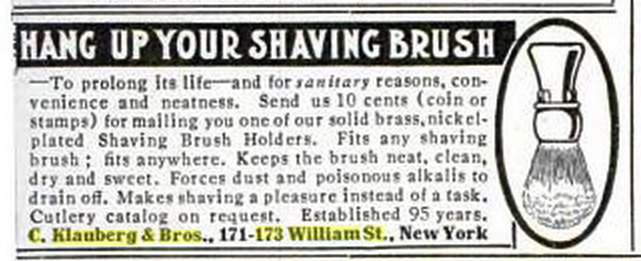Results 1 to 4 of 4
Thread: 7 Day C Klauberg & Bros
Hybrid View
-
05-24-2015, 07:09 PM #1Junior Member

- Join Date
- Aug 2014
- Location
- Somerset NJ United States
- Posts
- 17
Thanked: 0 7 Day C Klauberg & Bros
7 Day C Klauberg & Bros
Got theses from a friend that I work with, I gave them back and told him to ebay them but he said he did not want them and he owed me one so I can keep them. I have a Klauberg Bros razor so I know the make and I found Masterpiece razors on the web what I didnt find was the marking Fine India Steel for Klaubreg but these are made in England .
So is the quality of the steel the same as a Sheffield or of a lesser quality?
Any info would be helpful
-
05-24-2015, 07:40 PM #2Senior Member



- Join Date
- Mar 2012
- Location
- Thunder Bay, Ontario, Canada
- Posts
- 17,334
Thanked: 3228
Can't really say exactly what "Fine India Steel" is but I do have a Boker with that on the blade. Again I don't know if it is different from "Silver Steel" but that Boker takes as good an edge as any of my other Bokers. I think you are pretty safe with the quality of "Fine India Steel".
BobLife is a terminal illness in the end
-
The Following User Says Thank You to BobH For This Useful Post:
SANS1 (05-24-2015)
-
05-24-2015, 08:34 PM #3Junior Member

- Join Date
- Aug 2014
- Location
- Somerset NJ United States
- Posts
- 17
Thanked: 0
Thanks Bob besides for the one that is broke there in pretty good shape. I think I'm going to restore them but I want to know what the Fine India Steel is before I start.
-
05-24-2015, 08:49 PM #4Senior Member



- Join Date
- Apr 2008
- Location
- Essex, UK
- Posts
- 3,816
Thanked: 3164
Unless C. Klauberg & Bros. had a manufactory in the UK, then the razors were made, in Sheffield (probably) and Klauberg & Bros imported them with their name pre-stamped on them - a common practice.
India Steel is synonymous with 'wootz' steel - made in India and widely exported. It is the basis for Damascus steel, being imported to that city as wootz cake-billets and reworked by Arabs.
Wootz in itself simply means steel - a crucible steel that does not necessarily have a pattern.
Experimenters like Faraday, Mushet and Huntsman took wootz as their inspiration for attempting different crucible steel recipes - their results do not have a damascus-like pattern, but to say that wootz played no part in their making is wrong.
Patterned damascus steel stepped off the worlds stage rather dramatically in the mid 1700s - one theory is that the wootz from India came from another source that lacked vanadium, a crucial ingredient. The unpatterned variety was still called 'wootz' though - the word itself is accepted to mean just 'steel' - and it still came from India. Indian Steel.
Most authorities agree that it is impossible to define what wootz really was. The most basic definition is that it was any steel made using a crucible. However, although wootz was a crucible steel, not all crucible steels are wootz . can only confuse the issue more.
James Stodard (1760 - 1823), the famous Strand cutler who assisted Faraday in the alloys of steel experiments (c1819-2)had the indian symbol for wootz as his makers mark before he colluded with Faraday. We find that the business carried on, still importing steel from India as witnessed by the Bengal and Agra Directory of 1841:

The following C. Klauberg & Bros advert appeared in a 1914 newspaper:

The ad says that the firm was established for 95 years at that date, making their initial appearance around 1819, so contemporary with a time that was importing genuine wootz from India (some say that the trade was made illegal later on by the english, but some works - seen by eyewitnesses - continued to make the product until quite late.
So if the blades were early enough they would have been made of true Indi steel. However, like the real silver steel that enjoyed a vogue around this time (1820s) the silver was soon dispensed with, so that later blades have no silver element to them and were stil called silver steel. I expect the same thing happened with India Steel and Damascene Steel - the real thing in the early days, but just advertising hype in later days.
Regards,
Neil
-


 3Likes
3Likes
 LinkBack URL
LinkBack URL About LinkBacks
About LinkBacks






 Reply With Quote
Reply With Quote